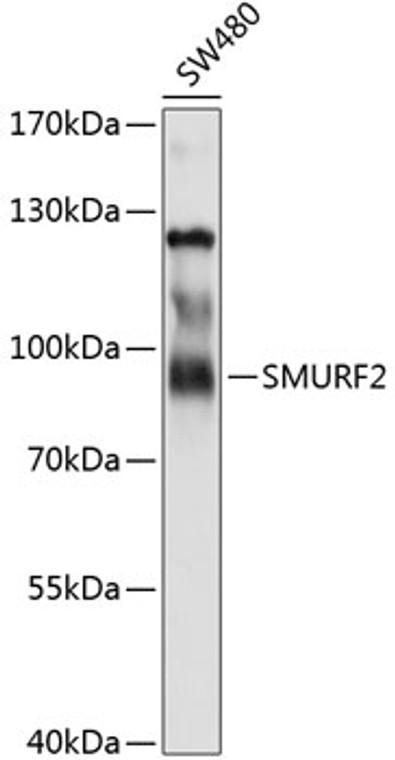| Host: |
Rabbit |
| Applications: |
WB |
| Reactivity: |
Human |
| Note: |
STRICTLY FOR FURTHER SCIENTIFIC RESEARCH USE ONLY (RUO). MUST NOT TO BE USED IN DIAGNOSTIC OR THERAPEUTIC APPLICATIONS. |
| Short Description: |
Rabbit polyclonal antibody anti-SMURF2 (150-250) is suitable for use in Western Blot research applications. |
| Clonality: |
Polyclonal |
| Conjugation: |
Unconjugated |
| Isotype: |
IgG |
| Formulation: |
PBS with 0.02% Sodium Azide, 50% Glycerol, pH7.3. |
| Purification: |
Affinity purification |
| Dilution Range: |
WB 1:1000-1:2000 |
| Storage Instruction: |
Store at-20°C for up to 1 year from the date of receipt, and avoid repeat freeze-thaw cycles. |
| Gene Symbol: |
SMURF2 |
| Gene ID: |
64750 |
| Uniprot ID: |
SMUF2_HUMAN |
| Immunogen Region: |
150-250 |
| Immunogen: |
Recombinant fusion protein containing a sequence corresponding to amino acids 150-250 of human SMURF2 (NP_073576.1). |
| Immunogen Sequence: |
DCSRLFDNDLPDGWEERRTA SGRIQYLNHITRTTQWERPT RPASEYSSPGRPLSCFVDEN TPISGTNGATCGQSSDPRLA ERRVRSQRHRNYMSRTHLHT P |
| Tissue Specificity | Widely expressed. |
| Post Translational Modifications | Auto-ubiquitinated and ubiquitinated in the presence of RNF11 and UBE2D1. Ubiquitinated by the SCF(FBXL15) complex and TTC3, leading to its degradation by the proteasome. 'Lys-48'-linked polyubiquitination mediated by TRAF4 at Lys-119 leads to SMURF2 proteasomal degradation. |
| Function | E3 ubiquitin-protein ligase which accepts ubiquitin from an E2 ubiquitin-conjugating enzyme in the form of a thioester and then directly transfers the ubiquitin to targeted substrates. Interacts with SMAD7 to trigger SMAD7-mediated transforming growth factor beta/TGF-beta receptor ubiquitin-dependent degradation, thereby down-regulating TGF-beta signaling. In addition, interaction with SMAD7 activates autocatalytic degradation, which is prevented by interaction with AIMP1. Also forms a stable complex with TGF-beta receptor-mediated phosphorylated SMAD1, SMAD2 and SMAD3, and targets SMAD1 and SMAD2 for ubiquitination and proteasome-mediated degradation. SMAD2 may recruit substrates, such as SNON, for ubiquitin-dependent degradation. Negatively regulates TGFB1-induced epithelial-mesenchymal transition and myofibroblast differentiation. (Microbial infection) In case of filoviruses Ebola/EBOV and Marburg/MARV infection, the complex formed by viral matrix protein VP40 and SMURF2 facilitates virus budding. |
| Protein Name | E3 Ubiquitin-Protein Ligase Smurf2Hsmurf2Hect-Type E3 Ubiquitin Transferase Smurf2Smad Ubiquitination Regulatory Factor 2Smad-Specific E3 Ubiquitin-Protein Ligase 2 |
| Database Links | Reactome: R-HSA-201451Reactome: R-HSA-2173788Reactome: R-HSA-2173795Reactome: R-HSA-4608870Reactome: R-HSA-4641257Reactome: R-HSA-5632684Reactome: R-HSA-5689880Reactome: R-HSA-8941858Reactome: R-HSA-983168 |
| Cellular Localisation | NucleusCytoplasmCell MembraneMembrane RaftCytoplasmic In The Presence Of Smad7Colocalizes With Cav1Smad7 And Tgf-Beta Receptor In Membrane Rafts |
| Alternative Antibody Names | Anti-E3 Ubiquitin-Protein Ligase Smurf2 antibodyAnti-Hsmurf2 antibodyAnti-Hect-Type E3 Ubiquitin Transferase Smurf2 antibodyAnti-Smad Ubiquitination Regulatory Factor 2 antibodyAnti-Smad-Specific E3 Ubiquitin-Protein Ligase 2 antibodyAnti-SMURF2 antibody |
Information sourced from Uniprot.org
12 months for antibodies. 6 months for ELISA Kits. Please see website T&Cs for further guidance







